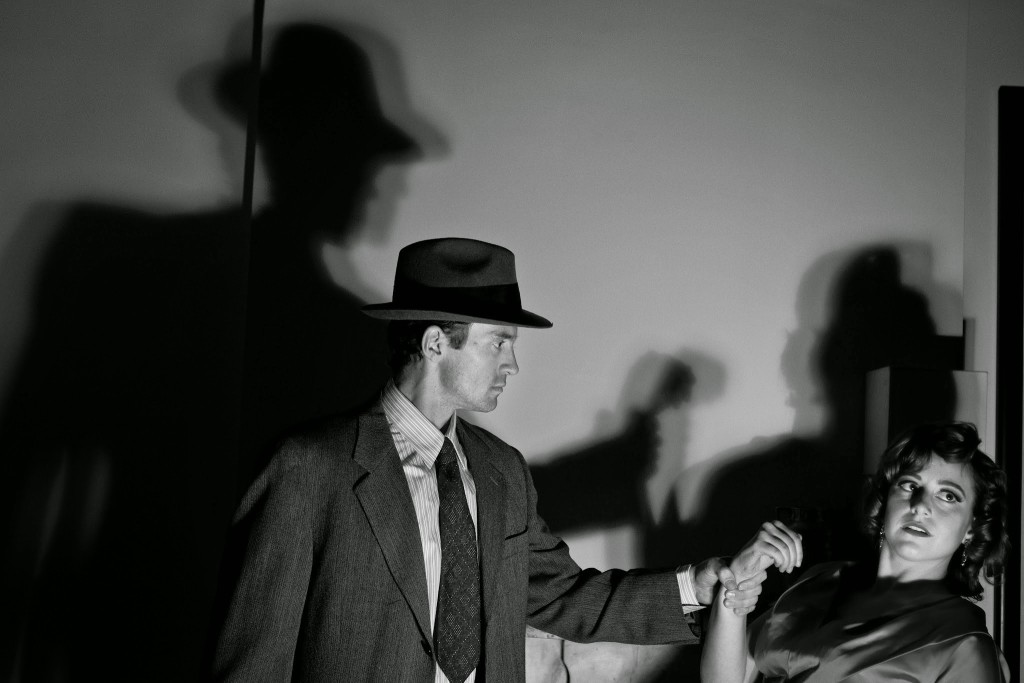
“Kill Me Like You Mean It” repositions the noir genre with a 100-proof cast and a sidelong glance into the abyss.
Jon Stancato, co-artistic director of Stolen Chair Theatre Company, glances at a wall near the basement entrance of the 4th Street Theatre, where Stolen Chair’s current offering, “Kill Me Like You Mean It,” is now playing. Here the reviews of the show, a revival of the company’s 2007 production, are taped up for ticket buyers to see, and they are good.
Yet Stancato, who directed both versions, cannot hide his disappointment.
“Parody is an easier sound bite.”
He is careful to express appreciation—gratitude, even—for what he considers to be raves, but it is not a label he is entirely comfortable with.
“I think the second you combine genre with humor,” says Stancato, “then it just gets slotted into this mode where you start to read everything as parody.”
As the playwright and co-artistic director Kiran Rikhye presents it, “Kill Me Like You Mean It” was never intended as parody or homage. But Stancato’s summary of their work—“this really fascinating, sophisticated mash-up of the tropes of the absurd and the tropes of film noir”—probably is not the best sales pitch, and they know this.
“Kill Me Like You Mean It” follows world-weary private detective Ben Farrell, played by Nathan Darrow—better known for the role of Edward Meechum, the intimately involved bodyguard to the President and First Lady on “House of Cards”—as he looks into the disappearance of celebrated pulp fiction writer Tommy Dickie. Farrell soon discovers that the missing writer’s serial installments uncomfortably foreshadow his own detective work, as if Dickie’s pen itself is the culprit. And his latest, unpublished story just might bring about Farrell’s own demise.
As producers for Stolen Chair (these longtime partners wear many, many hats, which is often the case with small theater companies), part of Rikhye and Stancato’s shared challenge has been to sell the show to a general public unfamiliar with their work. Or even to audience members of their own previous plays who, considering the company’s proudly divergent approach to production style and delivery, might have no idea what to expect this time around. “We went from a live silent film in 2013 to a spoken word opera in 2014,” says Stancato, looking back at Stolen Chair’s recent lineup.
So even though a great deal of creative energy and rehearsal time has been dedicated to preventing the whole thing from sliding into spoof or camp, it is easier to accept the lampoon tag many reviewers have stuck to the play in hopes that readers respond and, more importantly, come.
And yes, the detective wears a fedora, characters pursue each other down shadowy alleyways, femme fatales show up with even shadowier motives, and penetrating light slices through Venetian blinds. Check, check, check, check.
Still, to anyone who caught the show back in 2007, the current storyline probably won’t be too familiar. After all, “Kill Me Like You Mean It” this time around isn’t a revival, strictly speaking. The playwright and director both describe the earlier version as a “workshop,” and they are eager to make clear that what patrons experience now is more of a reworking, a complete overhaul, than a restaging.
So what has changed? “A lot,” Rikhye answers, with a laugh. “A lot, a lot.”
Which means, for starters, a brand new plot, almost every scene rewritten, one character cut entirely, and audience members brought onstage—all in an attempt to crystalize and humanize what Rikhye considers to be one of the play’s main themes: “encountering, oh you know, the meaningless of life . . . what it means to take action in the world knowing that your individual actions probably don’t matter that much in the grand scheme of things.”
But funny!
Noir is not known for its broad comedy, but the madcap, absurdist humor with which Rikhye and Stancato have infused “Kill Me Like You Mean It” is just one of the ways the genre is being retooled for modern audiences in order to highlight and exaggerate its ambiguities.
In actuality, noir has never really gone away, and now ‘neo-noir’ is having something of a moment. Recent additions to the form include such movies as Drive, Nightcrawler, and Gone Girl and TV series like “True Detective,” the upcoming “Twin Peaks” reboot, and yes, even “House of Cards.”
True, none of these productions would be mistaken for a parody, but, like “Kill Me Like You Mean It,” each have taken fundamental elements of noir—whether thematic or stylistic—and repackaged them for viewers as something nearly new yet familiar. These recent reinventions are united not only by that characteristic visual coolness but also a willingness to swap moral black-and-whites for grey. Lots and lots of grey.
Which helps explain why Stolen Chair’s production is so hard to pin down. Explaining Farrell’s character, Darrow starts by saying, “You do generally see a kind of everyman playing the detective or you see, I guess, everyman qualities on a person, but then again . . .” and he drops this line of thought to recall, instead, a passage from an early Raymond Chandler story in which the Philip Marlowe–esque figure removes and pockets a woman’s underpants from the crime scene.
“And you don’t hear anything else about it. No other mention.”
What are we to make of this? Modern audiences have come to expect their protagonists to arrive with messy backstories and inconsistencies of character. What Darrow seems to be getting at is that motive—and by extension, human nature—is anyone’s guess. At first glance, the noir hero may indeed be that everyman archetype, but it hardly means he isn’t also a messy, complex, possibly unredeemable individual.
“He’s also a single, alone man who likes to get into trouble, doesn’t he?” asks Darrow rhetorically.
The individuals populating “Kill Me Like You Mean It” do indeed enjoy trouble, and Rikhye and Stancato have found ways to make sure the audience feels complicit in it.
In “House of Cards,” Kevin Spacey’s Frank Underwood periodically turns to the camera to address viewers in an I’m-on-to-you-watching-me-now-let’s-have-some-fun-together sort of way. In its own manner, Stolen Chair plays a similar game of cat and mouse with audiences by transplanting film noir cinematography to the stage. Stancato and cast deliberately rehearsed as though being recorded by camera setups that changed continuously. The goal was to achieve, in Darrow’s words, “these little moments that almost seem like they are shaped for just the one person in that one seat.”
The effect is as intimate as it is isolating and unsettling. That forced perspective helps bring out the play’s true bite, which lies in the fruitless repetition of dialogue and action—cigarettes continually being offered, received, and tossed to the ground unsmoked; feverishly circling conversations that wind up back where they started. Yet the characters push on, because they are either unaware or all too aware of the utter ridiculousness of, well, everything.
In a comedic confrontation with Farrell, Lydia Forsythe, the publisher of the pulp magazine Murder Monthly (where Dickie’s foreboding words are printed), manages to produce an endless supply of pie charts reflecting ever-fluctuating data on the breakdown of her readership. But she does so with such cavalier investment in the numbers themselves and an eagerness to embrace each new, contradictory data set that it quickly becomes apparent neither she nor Farrell really give a goddamn. It is simply an activity to keep more pressing concerns—the nagging, mundane, everyday demons—at bay.
The audience laughs at the exchange, but what makes “Kill Me Like You Mean It” so engaging is that it’s never quite clear what, exactly, they’re laughing at. Perhaps it’s simply the setup and delivery. Or maybe it’s something else that draws out that laughter, the kind spurred by a deeper, more somber recognition of a shared futility.
Like all good crime pulp, “Kill Me Like You Mean It” ends with an onstage cliffhanger. But the true cliffhanger comes from the existential questions left unanswered after the stage lights fade to black. Or rather, to grey.
.
 David Speer is a writer and performer based in New York City.
David Speer is a writer and performer based in New York City.
